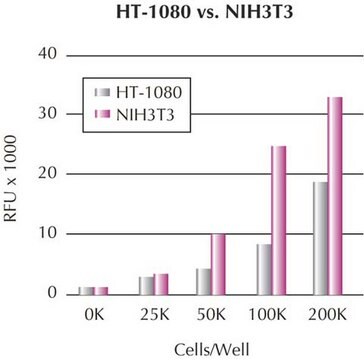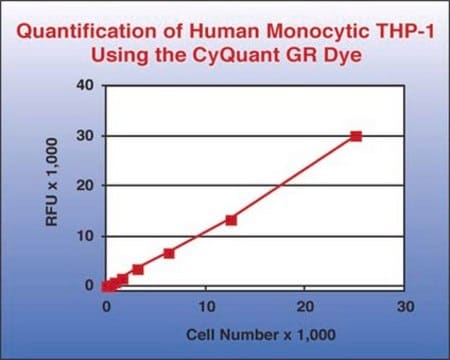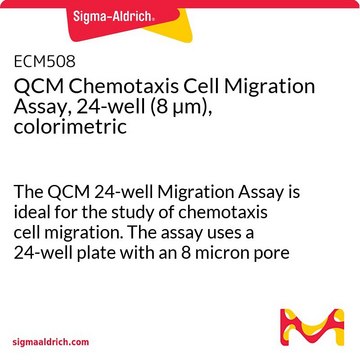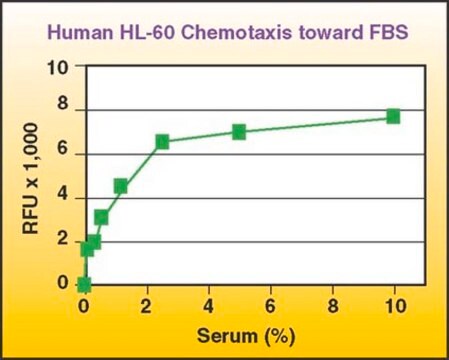ECM510
QCM Chemotaxis-Zellmigrationsassay, 96-Well (8 µm), fluorimetrisch
The QCM 8 uM 96-well Migration Assay utilizes a 8 um pore size, which is appropriate for leukocyte migration.
Synonym(e):
Fluorescent cell migration assay
Anmeldenzur Ansicht organisationsspezifischer und vertraglich vereinbarter Preise
Alle Fotos(2)
About This Item
UNSPSC-Code:
12352207
eCl@ss:
32161000
NACRES:
NA.32
Empfohlene Produkte
Qualitätsniveau
Speziesreaktivität (Voraussage durch Homologie)
all
Hersteller/Markenname
Chemicon®
QCM
Methode(n)
activity assay: suitable
cell based assay: suitable
Nachweisverfahren
fluorometric
Versandbedingung
wet ice
Allgemeine Beschreibung
Also available: Cell Comb™ Scratch Assay! Get biochemical data from a scratch assay!
Click Here
Introduction
Cell migration is a fundamental function of normal cellular processes, including embryonic development, angiogenesis, wound healing, immune response, and inflammation. Microporous membrane inserts are widely used for cell migration and invasion assays. The most widely accepted of which is the Boyden Chamber assay. However, current methods of analysis are time-consuming and tedious, involving cotton swabbing of non-migrated cells on the top side of insert, manual staining and counting. Recently a fluorescence blocking membrane insert was introduced to address these issues; however, this approach requires labeling of the cells with Calcein-AM and extensive washing to remove free Calcein before cell migration. The effect of this treatment on cell behavior/migration remains questionable.
The Chemicon QCM<TMSYMBOL></TMSYMBOL> 96-well Migration Assay does not require cell labeling, scraping, washing or counting. The 96-well insert and homogenous fluorescence detection format allows for large-scale screening and quantitative comparison of multiple samples.
In the Chemicon QCM<TMSYMBOL></TMSYMBOL> 96-well Migration Assay, migratory cells on the bottom of the insert membrane are dissociated from the membrane when incubated with Cell Detachment Buffer. These cells are subsequently lysed and detected by the patented CyQuant GR dye (Molecular Probes). This green-fluorescent dye exhibits strong fluorescence enhancement when bound to cellular nucleic acids.
The Chemicon QCM<TMSYMBOL></TMSYMBOL> 96-well Migration Assay provides a quick and efficient system for quantitative determination of various factors on cell migration, including screening of pharmacological agents, evaluation of integrins or other adhesion receptors responsible for cell migration, or analysis of gene function in transfected cells.
The Chemicon QCM<TMSYMBOL></TMSYMBOL> 96-well Migration Assay utilizes an 8 μm pore size, as this is appropriate for most cell types. This pore size supports optimal migration for most epithelial and fibroblast cells; however, it is not appropriate for lymphocyte migration experiments. The system may be adapted to study different types of cell migration, including haptotaxis, random migration, chemokinesis, and chemotaxis.
In addition, Chemicon also provides QCM<TMSYMBOL></TMSYMBOL> 24-well insert cell migration assay systems, CytoMatrix<TMSYMBOL></TMSYMBOL> Cell Adhesion strips coated with ECM proteins or anti integrin antibodies, and QuantiMatrix<TMSYMBOL></TMSYMBOL> ECM protein ELISA kits.
Application:
The Chemicon QCM<TMSYMBOL></TMSYMBOL> 96-well Migration Assay is ideal for the study of chemotaxis cell migration. The quantitative nature of this assay is especially useful for large scale screening of pharmacological agents. The 8 μm pore size of this assay′s Boyden chambers is appropriate for migration studies of most cell types. Each kit provides sufficient materials for the evaluation of 96 samples.
The Chemicon QCM<TMSYMBOL></TMSYMBOL> 96-well Migration Assay is intended for research use only; not for diagnostic applications.
Click Here
Introduction
Cell migration is a fundamental function of normal cellular processes, including embryonic development, angiogenesis, wound healing, immune response, and inflammation. Microporous membrane inserts are widely used for cell migration and invasion assays. The most widely accepted of which is the Boyden Chamber assay. However, current methods of analysis are time-consuming and tedious, involving cotton swabbing of non-migrated cells on the top side of insert, manual staining and counting. Recently a fluorescence blocking membrane insert was introduced to address these issues; however, this approach requires labeling of the cells with Calcein-AM and extensive washing to remove free Calcein before cell migration. The effect of this treatment on cell behavior/migration remains questionable.
The Chemicon QCM<TMSYMBOL></TMSYMBOL> 96-well Migration Assay does not require cell labeling, scraping, washing or counting. The 96-well insert and homogenous fluorescence detection format allows for large-scale screening and quantitative comparison of multiple samples.
In the Chemicon QCM<TMSYMBOL></TMSYMBOL> 96-well Migration Assay, migratory cells on the bottom of the insert membrane are dissociated from the membrane when incubated with Cell Detachment Buffer. These cells are subsequently lysed and detected by the patented CyQuant GR dye (Molecular Probes). This green-fluorescent dye exhibits strong fluorescence enhancement when bound to cellular nucleic acids.
The Chemicon QCM<TMSYMBOL></TMSYMBOL> 96-well Migration Assay provides a quick and efficient system for quantitative determination of various factors on cell migration, including screening of pharmacological agents, evaluation of integrins or other adhesion receptors responsible for cell migration, or analysis of gene function in transfected cells.
The Chemicon QCM<TMSYMBOL></TMSYMBOL> 96-well Migration Assay utilizes an 8 μm pore size, as this is appropriate for most cell types. This pore size supports optimal migration for most epithelial and fibroblast cells; however, it is not appropriate for lymphocyte migration experiments. The system may be adapted to study different types of cell migration, including haptotaxis, random migration, chemokinesis, and chemotaxis.
In addition, Chemicon also provides QCM<TMSYMBOL></TMSYMBOL> 24-well insert cell migration assay systems, CytoMatrix<TMSYMBOL></TMSYMBOL> Cell Adhesion strips coated with ECM proteins or anti integrin antibodies, and QuantiMatrix<TMSYMBOL></TMSYMBOL> ECM protein ELISA kits.
Application:
The Chemicon QCM<TMSYMBOL></TMSYMBOL> 96-well Migration Assay is ideal for the study of chemotaxis cell migration. The quantitative nature of this assay is especially useful for large scale screening of pharmacological agents. The 8 μm pore size of this assay′s Boyden chambers is appropriate for migration studies of most cell types. Each kit provides sufficient materials for the evaluation of 96 samples.
The Chemicon QCM<TMSYMBOL></TMSYMBOL> 96-well Migration Assay is intended for research use only; not for diagnostic applications.
Anwendung
Der QCM 8-µM-Migrationsassay mit 96 Wells verfügt über eine Porengröße von 8 µm, die für die Leukozyten-Migration geeignet ist.
Forschungskategorie
Zellstruktur
Zellstruktur
Verpackung
96 Wells
Komponenten
Sterile Zellmigrationsplatte mit 96 Wells: (Art.-Nr. 90128) Eine Anzuchtwanne mit 96 Wells und eine Zellmigrationskammerplatte mit 96 Wells. Fläche = 0,3 cm2, 50.000 Zellen pro Well
Zellkulturwanne mit 96 Wells: (Art.-Nr. 90129) Eine Anzuchtwanne mit 96 Wells
Zellablösungslösung: (Art.-Nr. 90131) Eine Flasche – 16 ml.
4X-Zelllysepuffer: (Art.-Nr. 90130) Eine Flasche – 16 ml.
CyQuant GR Dye1: (Art.-Nr. 90132) Ein Fläschchen – 75 μl
Zellkulturwanne mit 96 Wells: (Art.-Nr. 90129) Eine Anzuchtwanne mit 96 Wells
Zellablösungslösung: (Art.-Nr. 90131) Eine Flasche – 16 ml.
4X-Zelllysepuffer: (Art.-Nr. 90130) Eine Flasche – 16 ml.
CyQuant GR Dye1: (Art.-Nr. 90132) Ein Fläschchen – 75 μl
Rechtliche Hinweise
CELL COMB is a trademark of Merck KGaA, Darmstadt, Germany
CHEMICON is a registered trademark of Merck KGaA, Darmstadt, Germany
Haftungsausschluss
Sofern in unserem Katalog oder anderen Begleitdokumenten unserer Produkte nicht anders angegeben, sind unsere Produkte nur für Forschungszwecke vorgesehen und nicht für andere Zwecke zu verwenden, einschließlich, jedoch nicht beschränkt auf unautorisierte kommerzielle Verwendung, zur In-vitro-Diagnostik, für Ex-vivo- oder In-vivo-Therapiezwecke oder jegliche Art der Einnahme oder Anwendung bei Menschen oder Tieren.
Signalwort
Danger
H-Sätze
Gefahreneinstufungen
Aquatic Acute 1 - Aquatic Chronic 2 - Eye Dam. 1
Lagerklassenschlüssel
10 - Combustible liquids
Analysenzertifikate (COA)
Suchen Sie nach Analysenzertifikate (COA), indem Sie die Lot-/Chargennummer des Produkts eingeben. Lot- und Chargennummern sind auf dem Produktetikett hinter den Wörtern ‘Lot’ oder ‘Batch’ (Lot oder Charge) zu finden.
Besitzen Sie dieses Produkt bereits?
In der Dokumentenbibliothek finden Sie die Dokumentation zu den Produkten, die Sie kürzlich erworben haben.
Kunden haben sich ebenfalls angesehen
Zhaolu Wang et al.
Journal of cerebral blood flow and metabolism : official journal of the International Society of Cerebral Blood Flow and Metabolism, 32(2), 387-398 (2011-11-03)
Ischemic stroke affecting the adult brain causes increased progenitor proliferation in the subventricular zone (SVZ) and generation of neuroblasts, which migrate into the damaged striatum and differentiate to mature neurons. Meteorin (METRN), a newly discovered neurotrophic factor, is highly expressed
Nadia K Guimaraes-Souza et al.
Nephrology, dialysis, transplantation : official publication of the European Dialysis and Transplant Association - European Renal Association, 27(8), 3082-3090 (2012-01-31)
Recent advances in cell therapies have provided potential opportunities for the treatment of chronic kidney diseases (CKDs). We investigated whether human kidney structures could be preformed in vitro for subsequent implantation in vivo to maximize tissue-forming efficiency. Human renal cells
Rishipal R Bansode et al.
International journal of biological sciences, 7(5), 629-644 (2011-06-08)
The activity of N-hexanoyl-D-erythro-sphingosine, a C6-ceramide against angiogenesis was tested in vitro and in vivo. The effect of ceramide in inhibiting MCF-7 cancer cells was also determined. The aim of this study was to potentiate the effect of ceramide as
Hiroki Ono et al.
Arteriosclerosis, thrombosis, and vascular biology, 24(9), 1634-1639 (2004-07-10)
Migration of vascular smooth muscle cells (VSMCs) contributes to formation of vascular stenotic lesions such as atherosclerosis and restenosis after angioplasty. Previous studies have demonstrated that tumor necrosis factor-alpha (TNF-alpha) is a potent migration factor for VSMCs. cAMP-response element-binding protein
Janette M Birmingham et al.
Carcinogenesis, 30(4), 690-697 (2009-02-18)
Adipose tissue secretes factors linked to colon cancer risk including leptin. A hallmark of cancer is sustained angiogenesis. While leptin promotes angiogenesis in adipose tissue, it is unknown whether leptin can induce epithelial cells to produce factors that may drive
Unser Team von Wissenschaftlern verfügt über Erfahrung in allen Forschungsbereichen einschließlich Life Science, Materialwissenschaften, chemischer Synthese, Chromatographie, Analytik und vielen mehr..
Setzen Sie sich mit dem technischen Dienst in Verbindung.











